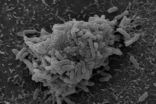(Press-News.org) ROSEMONT, Ill.─"Doctor shopping," the growing practice of obtaining narcotic prescriptions from multiple providers, has led to measurable increases in drug use among postoperative trauma patients. The study, "Narcotic Use and Postoperative Doctor Shopping in the Orthopaedic Trauma Population," appearing in the August issue of the Journal of Bone & Joint Surgery (JBJS), links doctor shopping to higher narcotic use among orthopaedic patients. The data was presented earlier this year at the 2014 Annual Meeting of the American Academy of Orthopaedic Surgeons (AAOS).
"There has been an alarming rise in opioid use in our country, and the diversion of opioids for non-therapeutic uses is dramatically increasing," said lead study author, orthopaedic surgeon Brent J. Morris, MD. "Many suspect that orthopaedic trauma patients may be at a higher risk for pre-injury narcotic use and 'doctor shopping.'"
Researchers reviewed prescription records for 151 adult patients admitted to an orthopaedic unit at a Level 1 trauma center between January and December 2011. Using the Tennessee Controlled Substance Monitoring Database (CSMD), the study authors reviewed data on narcotic prescriptions obtained three months before, and within six months after, each patient's orthopaedic procedure.
The research found that 20.8 percent of patients sought prescription pain medications from multiple providers. When compared to patients who continued to receive prescriptions and care from a single provider, the "doctor shoppers":
Used narcotics four times longer than single provider patients (112 days versus 28 days).
Obtained a median of seven narcotic prescriptions compared to two prescriptions for single provider patients.
Had a higher morphine equivalent dose (MED) of narcotics each day (43 milligrams versus 26 milligrams).
Were 4.5 times more likely to seek out an additional provider if they had a history of preoperative narcotic use.
The "doctor shopping" patients had an average age of 39.6 ±12.2 years, and were primarily white (89 percent) and male (63 percent). Forty-four percent were uninsured. There were no differences between the single-provider and multiple-provider groups with regard to age, sex, race, injury type, distance between the patient's home and treating hospital, tobacco use, psychiatric history (depression, anxiety, attention deficit hyperactivity disorder, or bipolar disorder), or comorbidities.
"Our study determined that one out of five of our orthopaedic trauma patients obtained narcotic prescriptions from another provider after surgery while still receiving narcotic prescriptions from the treating surgeon," said Dr. Morris.
"Our study highlights the importance of counseling patients in the postoperative period, and that it is important to work together to establish reasonable expectations for pain control as part of treatment plan discussions and follow-up visits," said Dr. Morris. "A standardized pain protocol for specific operative and non-operative treatment plans with an opioid taper may also be helpful."
INFORMATION:
Study Details
Eligible patients were between the ages of 18 and 65 and had an isolated, operative orthopaedic injury requiring admission from the emergency department to the orthopaedic trauma service. Criteria for exclusion included patients with multiple traumatic injuries, including those with more than one extremity injured; primary residence in a state other than the state of the treating institution; postoperative complication requiring repeat operation; incarceration; and/or incomplete data in the controlled substance monitoring database. The Tennessee Controlled Substance Monitoring Database (CSMD) was used to identify all narcotic prescriptions filled three months prior to hospital admission and six months following discharge from the hospital. The database includes patient names, date of birth and sex; narcotic dosage and quantity; prescriber; and date that the prescription was filled.
AAOS on Facebook, Twitter and Google+
Study: 1 out of 5 adult orthopaedic trauma patients sought additional providers for narcotic prescriptions
Postoperative 'doctor shopping' linked to higher narcotic use among orthopaedic patients
2014-08-11
ELSE PRESS RELEASES FROM THIS DATE:
Keeping viruses at bay
2014-08-11
>
Our immunosensory system detects virus such as influenza via specific characteristics of viral ribonucleic acid. Previously, it was unclear how the immune system prevents viruses from simply donning molecular camouflage in order to escape detection. An international team of researchers from the University of Bonn Hospital and the London Research Institute have now discovered that our immunosensory system attacks viruses on a molecular level. In this way, a healthy organism can keep rotaviruses, a common cause of diarrheal epidemics, at bay. The results have been published ...
Fertile discovery
2014-08-11
Queen's University researcher Richard Oko and his co-investigators have come up with a promising method of treating male infertility using a synthetic version of the sperm-originated protein known as PAWP.
They found this protein is sufficient and required to initiate the fertilization process.
Dr. Oko's research promises to diagnose and treat cases of male factor infertility where a patient's sperm is unable to initiate or induce activation of the egg to form an early embryo.
"PAWP is able to induce embryo development in human eggs in a fashion similar to the natural ...
Penn-led expert panel calls for public health research on natural gas drilling
2014-08-11
PHILADELPHIA – Groundwater and air quality testing before, during, and after natural gas drilling – which includes hydraulic fracturing -- should be key components of efforts to ensure the safety of communities near these sites, according to an expert panel convened to weigh in on public health research needs associated with unconventional natural gas drilling operations (UNGDO). The panel also urges that any research conducted should use "community-based participatory research principles" so that the concerns of the many stakeholders involved in these activities can be ...
Rutgers researchers show that how fast you drive might reveal exactly where you are going
2014-08-11
In our constantly connected, information-rich society, some drivers are jumping at the chance to let auto insurance companies monitor their driving habits in return for a handsome discount on their premiums.
What these drivers may not know is that they could be revealing where they are driving, a privacy boundary that many would not consent to cross.
A team of Rutgers University computer engineers has shown that even without a GPS device or other location-sensing technology, a driver could reveal where he or she traveled with no more information than a starting location ...
School violence, gun-related injury among top 10 child health concerns nationally
2014-08-11
ANN ARBOR, Mich. – Childhood obesity remains the top health concern for children in 2014, but when asked about national concerns, adults put school violence and gun-related injuries in the top 10, according to a new University of Michigan C.S. Mott Children's Hospital National Poll on Children's Health.
In the poll's annual top 10 list, a nationwide sample of adults were asked to identify the biggest health concerns for kids in their communities, as well as kids nationwide. Overall, childhood obesity is rated at the top of both lists: 29 percent of adults said obesity ...
Inequality -- a key issue of economic research
2014-08-11
In the aftermath of the global financial crisis and the ensuing economic and political disruptions, inequality has re-emerged as a central focus of public debate. The drivers of rising inequality of income and wealth and the various scientific models for counteractive measures will be among the central topics debated among 17 Nobel Laureates in Economic Sciences and approximately 450 aspiring young economists from more than 80 countries in Lindau, Germany, next week. The 5th Lindau Meeting on Economic Sciences will bring them together for a unique dialogue across generations, ...
Clues emerge to genetic architecture of cognitive abilities in children
2014-08-11
How genes affect intelligence is complicated. Multiple genes, many yet unknown, are thought to interact among themselves and with environmental factors to influence the diverse abilities involved in intelligence.
A large new genetic study in thousands of children and adolescents offers early glimpses of the overall patterns and connections among cognitive abilities such as language reasoning, reading skill and types of memory. The findings may lead to new tools in understanding human cognitive development and neuropsychiatric disorders.
"This research is one of the ...
More intensive interventions needed to combat severe obesity in teens
2014-08-11
New Rochelle, NY, August 11, 2014 -- Nearly 6% of all children and teens in the U.S. are severely obese, and the prevalence of severe obesity is increasing faster than that of moderate obesity or overweight. This is an alarming trend as about 90% of these youths will grow up to be obese adults. The serious health problems associated with severe obesity and the poor long-term prognosis and quality of life projected for these children and teens demand more serious consideration of safe and effective treatment options that go beyond diet and lifestyle modifications, as proposed ...
Pairing old technologies with new for next-generation electronic devices
2014-08-11
UCL scientists have discovered a new method to efficiently generate and control currents based on the magnetic nature of electrons in semi-conducting materials, offering a radical way to develop a new generation of electronic devices.
One promising approach to developing new technologies is to exploit the electron's tiny magnetic moment, or 'spin'. Electrons have two properties – charge and spin – and although current technologies use charge, it is thought that spin-based technologies have the potential to outperform the 'charge'-based technology of semiconductors for ...
Sugary bugs subvert antibodies
2014-08-11
A lung-damaging bacterium turns the body's antibody response in its favor, according to a study published in The Journal of Experimental Medicine.
Pathogenic bacteria are normally destroyed by antibodies, immune proteins that coat the outer surface of the bug, laying a foundation for the deposition of pore-forming "complement" proteins that poke lethal holes in the bacterial membrane. But despite having plenty of antibodies and complement proteins in their bloodstream, some people can't fight off infections with the respiratory bacterium Pseudomonas aeruginosa. And chronic ...
LAST 30 PRESS RELEASES:
Collaborative study uncovers unknown causes of blindness
Inflammatory immune cells predict survival, relapse in multiple myeloma
New test shows which antibiotics actually work
Most Alzheimer’s cases linked to variants in a single gene
Finding the genome's blind spot
The secret room a giant virus creates inside its host amoeba
World’s vast plant knowledge not being fully exploited to tackle biodiversity and climate challenges, warn researchers
New study explains the link between long-term diabetes and vascular damage
Ocean temperatures reached another record high in 2025
Dynamically reconfigurable topological routing in nonlinear photonic systems
Crystallographic engineering enables fast low‑temperature ion transport of TiNb2O7 for cold‑region lithium‑ion batteries
Ultrafast sulfur redox dynamics enabled by a PPy@N‑TiO2 Z‑scheme heterojunction photoelectrode for photo‑assisted lithium–sulfur batteries
Optimized biochar use could cut China’s cropland nitrous oxide emissions by up to half
Neural progesterone receptors link ovulation and sexual receptivity in medaka
A new Japanese study investigates how tariff policies influence long-run economic growth
Mental trauma succeeds 1 in 7 dog related injuries, claims data suggest
Breastfeeding may lower mums’ later life depression/anxiety risks for up to 10 years after pregnancy
Study finds more than a quarter of adults worldwide could benefit from GLP-1 medications for weight loss
Hobbies don’t just improve personal lives, they can boost workplace creativity too
Study shows federal safety metric inappropriately penalizes hospitals for lifesaving stroke procedures
Improving sleep isn’t enough: researchers highlight daytime function as key to assessing insomnia treatments
Rice Brain Institute awards first seed grants to jump-start collaborative brain health research
Personalizing cancer treatments significantly improve outcome success
UW researchers analyzed which anthologized writers and books get checked out the most from Seattle Public Library
Study finds food waste compost less effective than potting mix alone
UCLA receives $7.3 million for wide-ranging cannabis research
Why this little-known birth control option deserves more attention
Johns Hopkins-led team creates first map of nerve circuitry in bone, identifies key signals for bone repair
UC Irvine astronomers spot largest known stream of super-heated gas in the universe
Research shows how immune system reacts to pig kidney transplants in living patients
[Press-News.org] Study: 1 out of 5 adult orthopaedic trauma patients sought additional providers for narcotic prescriptionsPostoperative 'doctor shopping' linked to higher narcotic use among orthopaedic patients



